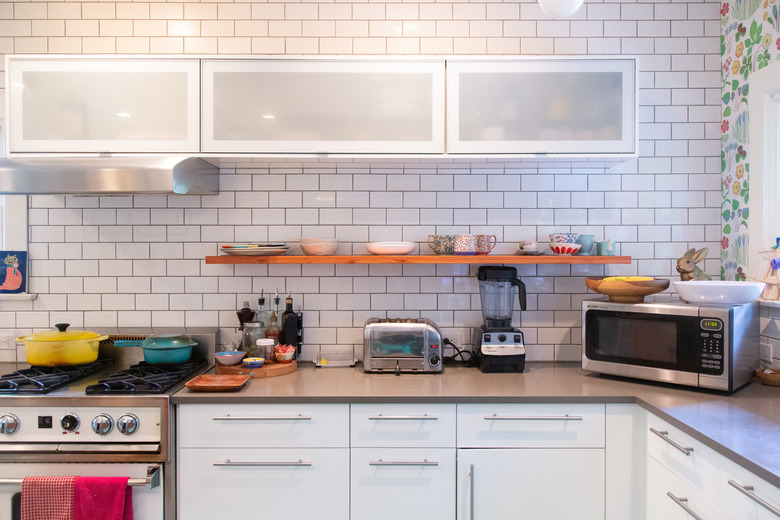How To Clean Tile Grout
Cleaning tile surfaces is generally a fairly straightforward task and is made even easier with regular maintenance. Cleaning grout, on the other hand, takes quite a bit more effort. You can get the job done with commercial grout cleaner as well as various household cleaners and basic techniques. Sometimes, when tile becomes badly stained by dirt, food or even mold, tile grout may need to be restored rather than deep cleaned.
Keeping Grout Clean
Keeping Grout Clean
The easiest way to clean grout is to make it part of your weekly cleaning routine, which can reduce the amount of stains that build up over time. Mopping your floors will go a long way in keeping your tiles clean, but dirty water can set in the grout joints, which may contribute to dirty or even moldy grout lines over time. One way to keep your grout clean is to thoroughly dry your floors, walls or countertops with a clean, dry towel after you clean them. If you need to keep the grout in between your shower tiles clean, you can try using a squeegee as well.
If your tile floors haven't been dried after every wash, you can still keep your grout clean and looking its best by using the right cleaning product. For regular maintenance, a pH-neutral cleanser like Zep Neutral Floor Cleaner Concentrate will clean your grout joints effectively without damaging them.
For a deep clean, use an alkaline cleaner or stripping product like Granite Gold Grout Cleaner, which comes with a scrubbing brush to loosen dirt and help lift stains. It is recommended that you steer clear of cleaners that contain acid, including vinegar, as they may damage some ceramic and natural stone surfaces.
DIY deep cleaning solutions include white, non-gel toothpaste, which should be scrubbed into the surface with an old toothbrush, then rinsed clean with warm water and dish soap. Additionally, Dawn dish soap can de-grease and lift dirt and stains when used with a scrubbing brush, as will a Magic Eraser when run under clean water.
How to Deep Clean Grout
How to Deep Clean Grout
While the best way to stay on top of grout lines is routine cleaning, sometimes, dingy grout can catch up with us. Deep grout cleaning may need to be done from time to time to lift stains and revive color. Fortunately, this can be done using just a few items and a little bit of elbow grease.
- Cover grout with warm, clean water and use a soft-bristled brush to gently scrub the grout with circular motions.
- Using a spray bottle, spray grout with an alkaline cleanser and let it sit for about three minutes.
- Using your scrubbing brush, scrub the grout joint to allow the product to penetrate the surface and lift dirt and stains.
- Rinse the area with warm, clean water.
- Use a clean, dry towel to thoroughly dry the surface as best you can. You can also open any windows in the room or run a fan to ensure that the surface is completely dry, which can prevent mold from growing.
How to Restore Tile Grout
How to Restore Tile Grout
For extra tough cases, steam scrubbing tile grout may be the best option, and can be done either by homeowners or professionals, depending on the job. Steam cleaning grout uses hot water to extract dirt and debris from deep within the porous surface of grout, resulting in a much deeper clean than basic surface scrubbing can provide.
To steam scrub your grout yourself, you can rent a commercial steam cleaner from a local home center or rental outlet. Make sure to get one with a small scrubber nozzle designed for grout. Follow the manufacturer's directions for cleaning. However, if your tile or grout is old, loose or cracked, enlisting the help of a professional may be the safest bet for getting your tiles clean without possibly adding further damage.
When it comes to cleaning especially stained or dirty grout joints, sometimes there is no amount of scrubbing that will suffice. In this case, it's best to restore your grout by using a grout saw or multitool to slowly and carefully remove the old grout, then regrout the tile.
- Using a grout saw, carefully remove all of the grout from between your tiles. Be sure to work slowly and deliberately to avoid possibly scratching the surface of nearby tiles with the saw.
- Using new grout, replace what you just removed. When replacing grout, it's important to understand what type of grout to use. As a rule of thumb, the wider the joint, the more coarse the sand used in that type of grout.
- Wet your grout joints with a damp sponge. Then, use a rubber float to fit the grout into the joint by tipping the tool at a 45-degree angle and moving it from corner to corner using sweeping diagonal motions.
- Once your grout is applied, use a wet sponge to wipe away any grout that has touched the surface of any tiles.
References
- Ron Hazelton: How to Replace Tile Grout in a Kitchen Countertop
- BuildDirect: How to Choose Grout for Ceramic Tile: Facts & Considerations
- John Bridge: Tile Shower: How to Maintain It
- North American Tile Cleaning Organization: Alkaline, Acidic, and pH Neutral Tile, Grout, and Stone Cleaning Products
- Molly Maid: Use Toothpaste to Whiten Tile Grout
- Dupray: How to Clean Grout with a Steam Cleaner


